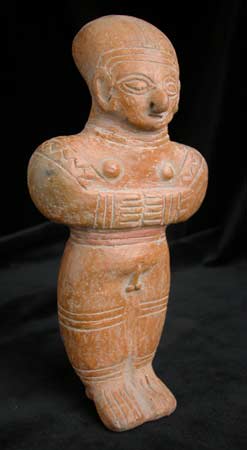Bahia Sculpture of a Standing Man, 200 BCE - 600 CE
Terracotta
3.75 x 7.75
PF.2610
Further images
The Pre-Columbian cultures of Ecuador are among the oldest in South America and among the first to master the art of pottery. Although we know little about the peoples themselves...
The Pre-Columbian cultures of Ecuador are among the oldest in South America and among the first to master the art of pottery. Although we know little about the peoples themselves or their traditions, historians have been able to piece together a picture of life in Ancient Ecuador thanks in part to the art and artifacts left behind. The culture of Valdivia created some of the oldest known works of art in the Americas. Situated along the coastal strip of Ecuador, the Valdivians established a thriving society that flourished for around two thousand years (from approximately 4000 to 1500 B.C.). Today they are famed for their small fertility figures, believed to be the earliest representational works of art in the Americas, first carved from stone, later formed from terracotta.
Hundreds of years later after the Valdivians disappear from the archaeological record appears another culture to which the name Chorrera has been attached (lasting from circa 1100-300 B.C.). Little is known about this culture; however, it is significant for its widespread geographical reach. As such, their artistic style greatly influenced those diverse cultures that began to emerge in the final centuries of the Chorrera period, a time historians have labeled the Period of Regional Development.
Among the most prominent cultures that flourished in the wake of the Chorrera are the cultures of Bahia, Jama Coaque, and La Tolita. Around 200 B.C., the Bahia developed along the coastal strip in the modern province of Manabi, lasting until approximately 600 A.D. Their earliest terracotta works were greatly indebted to the Chorrera; however, over the years a distinctive style emerged characterized by large figures adorned with detailed dress and body ornamentation.
The Bahia phase of Ecuadorian ceramics had several sub styles of figurines, one of which is the Gaungala style. Here we see a stunning example of that ceramic style in the form of a standing figure with flattened feet and closely held legs that curve outward. The softly rounded lines of the legs continue upward as the figures folded arms bellow outward in a most aesthetically pleasing fashion. A large rounded headdress adds to the fine sense of balance and proportion, while inscribed patterns on the figure give a tactile, dimensional quality to the image. A viewing of the figure from behind reveals a small hole in the head and one in each shoulder, allowing the figure to become a whistle. Perhaps if we listen closely we can hear the mystical call of an Ancient Ecuadorian as this ancient figure reverberates with the sounds of a once-vibrant culture.
Hundreds of years later after the Valdivians disappear from the archaeological record appears another culture to which the name Chorrera has been attached (lasting from circa 1100-300 B.C.). Little is known about this culture; however, it is significant for its widespread geographical reach. As such, their artistic style greatly influenced those diverse cultures that began to emerge in the final centuries of the Chorrera period, a time historians have labeled the Period of Regional Development.
Among the most prominent cultures that flourished in the wake of the Chorrera are the cultures of Bahia, Jama Coaque, and La Tolita. Around 200 B.C., the Bahia developed along the coastal strip in the modern province of Manabi, lasting until approximately 600 A.D. Their earliest terracotta works were greatly indebted to the Chorrera; however, over the years a distinctive style emerged characterized by large figures adorned with detailed dress and body ornamentation.
The Bahia phase of Ecuadorian ceramics had several sub styles of figurines, one of which is the Gaungala style. Here we see a stunning example of that ceramic style in the form of a standing figure with flattened feet and closely held legs that curve outward. The softly rounded lines of the legs continue upward as the figures folded arms bellow outward in a most aesthetically pleasing fashion. A large rounded headdress adds to the fine sense of balance and proportion, while inscribed patterns on the figure give a tactile, dimensional quality to the image. A viewing of the figure from behind reveals a small hole in the head and one in each shoulder, allowing the figure to become a whistle. Perhaps if we listen closely we can hear the mystical call of an Ancient Ecuadorian as this ancient figure reverberates with the sounds of a once-vibrant culture.







